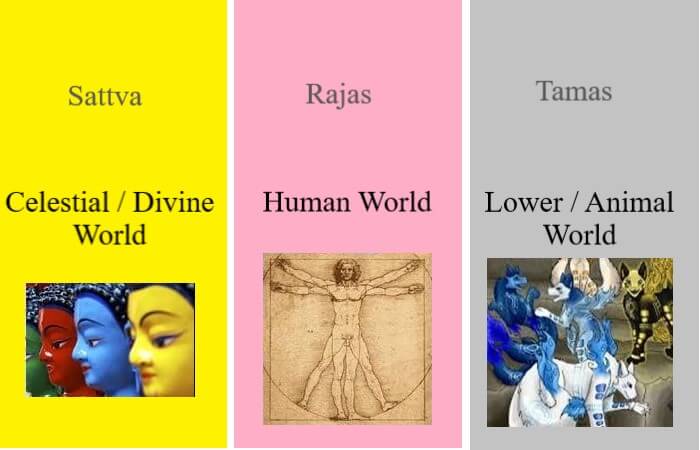Author: Randeep Singh / go to all Samkhya Karikas

Samkhya karika 54 text:
Oordhvam sattva vishaalastamovishaalashch moolatah sargah |
Madhye rajovishaalo brahmaadi stamba paryantah ||
Oardhvam – upper, above, transcendental
Sattva vishaalas – full of sattva guna
Tamovishaalash – abundant in tamas guna
Cha – and
Moolatah – root, below
Sargah – evolution
Madhye – middle
Rajovishaalo – Abundant with rajas guna
Brahmaadi – beginning with brahmma
Stamba paryantah – ending at the smallest blade of grass
Samkhya Karika 54 gives the explanation of the characteristics of the three levels, worlds into which the beings evolve from Prakriti (Mula Prakriti). Since Mula Prakriti (unmanifest state of Prakriti) is composed of three gunas (Sattva, Rajas & Tamas), the evolutes which emerge from it during the evolution process are also composed of three gunas present within each evolute in different proportions.
All the evolutes, elements which make up the material world are composed of all the three gunas, no material element can have existence if even one of the gunas is absent in them.
The classification of the three world’s is also based on the proportion of these three gunas present within them. The upper level world of celestial beings (Daivas) has Sattva as the predminant guna with lesser proportions of Rajas and Tamas.
In the lower level (world) Tamas predominates over the other two gunas, and in the middle level (humans) Rajas is predominant with Sattva and Tamas gunas remaining proportionally dormant.
Samkhya Karika 54 – Bhavas and Gunas make Three Worlds
Bhavas and gunas are interrelated: Though the three gunas evolve into Buddhi (as per the principles of evoltuion of Prakriti), practice or non-practice of the four positive bhavas can alter the composition of the three gunas.
Consistent practice of the four positive bhavas can enhance the proportion of Sattva in the intellect (Buddhi) leading to a divine desposition of the being. Such beings are the ones who belongto the upper or the celestial world.
Rajas guna dominates when this practice (of four positivebhavas) is inconsistent in nature. Such being belong to the middle world or the level at which ordinary humans exist. On the other hand when the intellect is overpowered by the negative bhavas Tamas guna predominates leading to a negative and dark disposition.
This last catagory is the lower level of world. All the three worlds, including the celestial world, are formed of matter as the building blocks of these are the three gunas which manifest from the source of all matter, the unmanifest Prakriti.
Samkhya karika 54 uses the word ‘Brahma’ as it represents the divine, celestial being which embodies the highest levels of Sattva guna. Brahma is one of the vedic Gods. Here the divine diety is being placed along the ordinary human beings as well as the lower, animal, level in order to make its position and existence understandable by the ordinary intellect of a ordinary human being.
This also clarifies that fact that the grosser evolutes of Prakriti (humans andlower worlds) share a common material existence with the divine beings and practice of positive bhavas can make them ascend to the higher or the celestial world. This also applies vice versa.
This karika canbe understood in a different context too. One can assume that the qualities which re beingconveyed are not for the three separate worlds but to three different nature which humans come to possess. Humanscan also be Sattvik, Rajasic, or Tamasic by nature depending on which guna is dominant within which individual.
Individuals who have progressed in their practice of spiritualiy and thus altered the state of their intellect (Buddhi) to more Sattvik in nature can be equatd to the divine or the celestial beings. Individuals ruled byTamas guna, as a predominant quality of thier intellect, always remain mired in dark thought and destructive action. Such individuals occupy the lower world or the lower strata of existence from among the three. These humans are more so like animals.
Individuals who are dilly dally between the two extremes come to be ruled by the Rajas guna. This is the middlw strata, level of existence og beings wherein fall the ordinary humans.
As per Samkhya philosophy one has to understand that its much more easier for the ordinary humans ti uplift their Sattva quality as they are the fence sitters. They possess more Sattva than that is present at the lower (animal level). So. humans just need a bit of determination to transform their intellect towards more Sattva that the inhabitants of the lower level (World) would need.
One has the responsibility to recognise this fact and work towards purifiying the intellect by practicing four bhavas, in one’s lifetime, and release oneself from the bindings of the material world. Realisation of Purusha is the ultimate aim of beings.
